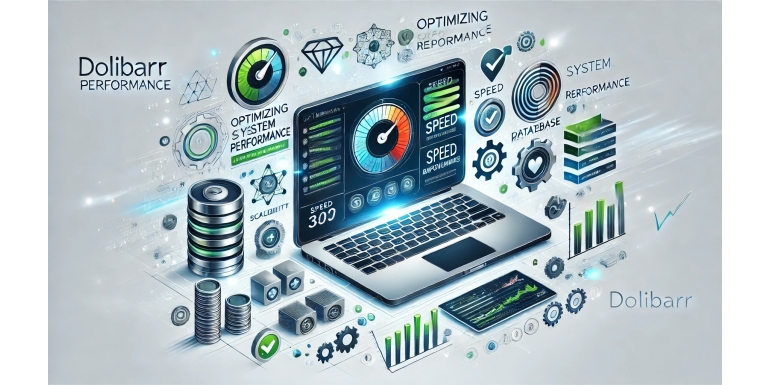
Introduction
Dolibarr is a widely used open-source ERP and CRM solution, appreciated for its flexibility and efficiency in managing business processes. However, like any software, Dolibarr can slow down over time if certain best practices are not followed.
Optimizing Dolibarr’s performance is essential to ensure better productivity, improve user experience, and avoid long response times that can hinder daily operations.
In this article, we will explore the best tips and recommendations to maximize Dolibarr’s speed and performance. Whether you are a system administrator or an end-user, these recommendations will help you get the most out of your Dolibarr installation.
1. Choosing High-Performance Hosting for Dolibarr
The choice of hosting is a crucial factor in Dolibarr’s execution speed. An undersized or misconfigured server can cause slowdowns and longer response times.
1.1. Shared or Dedicated Server?
- A shared server may suffice for a small business, but it quickly becomes limited as data and users increase.
- A dedicated server or VPS (Virtual Private Server) is recommended for better performance.
- Opt for Cloud hosting (AWS, OVH, DigitalOcean) if you need scalable performance.
1.2. Recommended Server Configurations
- Processor: Choose a CPU with multiple cores (Intel i7 or Xeon).
- RAM: Minimum 4GB for small businesses, 8GB or more for larger enterprises.
- SSD Storage: Prefer NVMe SSDs for optimal speed.
2. Optimizing MySQL/MariaDB Database Performance
Dolibarr relies mainly on a MySQL or MariaDB database, and poor configuration can affect performance.
2.1. Optimizing MySQL Configuration
Modify the my.cnf file to adjust the following settings:
These settings allow for efficient SQL query management and reduced processing time.
2.2. Cleaning and Indexing the Database
- Delete old records and unnecessary logs.
- Use the OPTIMIZE TABLE command to enhance data access.
- Regularly check database indexes to avoid slow queries.
3. Setting Up Effective Caching
3.1. Enable OpCode Cache with OPcache
Enabling OPcache reduces PHP script compilation time and significantly improves performance.
Add these lines to your php.ini file:
3.2. Enable MySQL Query Cache
Activating query_cache helps store the results of repetitive SQL queries, avoiding unnecessary overload.
Add this to your my.cnf file:
4. Optimizing Dolibarr Modules
4.1. Disable Unused Modules
Dolibarr offers many modules, but each activated module consumes resources. Check your needs and disable unused modules via:
Home > Configuration > Modules/Applications
4.2. Use Lightweight Extensions
If you need specific modules, prefer optimized modules developed by performance experts.
5. Improving File and Document Management
Documents and files stored in Dolibarr can slow down the system if not properly managed.
5.1. Optimized Document Storage
- Use external storage (Amazon S3, Google Drive) instead of overloading the Dolibarr server.
- Avoid uncompressed large files.
- Regularly clean old documents.
5.2. Compress Static Files
Enable Gzip compression to minimize the size of static files (CSS, JS, images).
Add this to your .htaccess file:
6. Securing and Monitoring Dolibarr to Prevent Slowdowns
6.1. Secure User Access
- Enable HTTPS for all connections.
- Use a Web Application Firewall (WAF) to block DDoS attacks.
- Limit login attempts with a security plugin.
6.2. Monitor Performance
Use tools like:
- New Relic to track PHP performance.
- MySQLTuner to audit the database.
- HTOP to monitor server load.
7. Regularly Updating Dolibarr
Dolibarr is continuously evolving with updates that provide security patches and performance improvements.
7.1. Checking for New Versions
- Go to Dolibarr > Home > Administration > System Info to check your current version.
- Download updates from the official website (www.dolibarr.org).
7.2. Safe Update Process
- Always back up the database before updating.
- Test new versions on a staging server before deploying them to production.
Conclusion
Optimizing Dolibarr doesn’t require advanced technical skills, but it does require applying best practices regularly. By following these recommendations, you will:
✅ Improve Dolibarr’s execution speed.
✅ Avoid slowdowns caused by the database and unused modules.
✅ Ensure optimal document and file management.
✅ Strengthen security to prevent intrusions.
Optimizing Dolibarr is a worthwhile investment that ensures better productivity for your business. Implement these tips today and boost your ERP’s performance!
